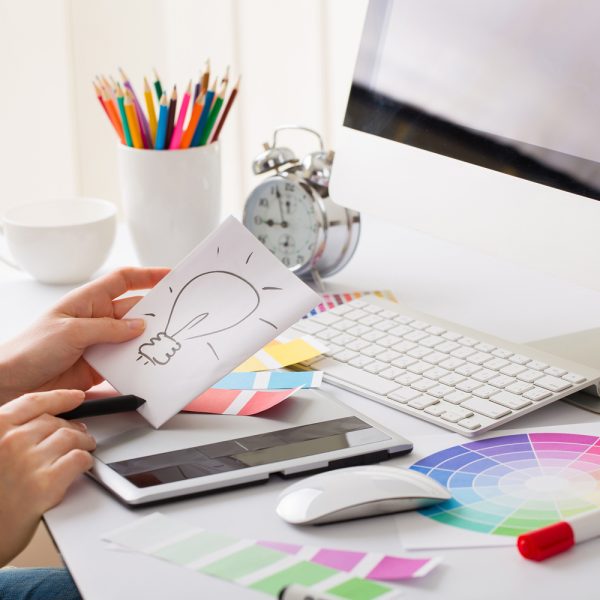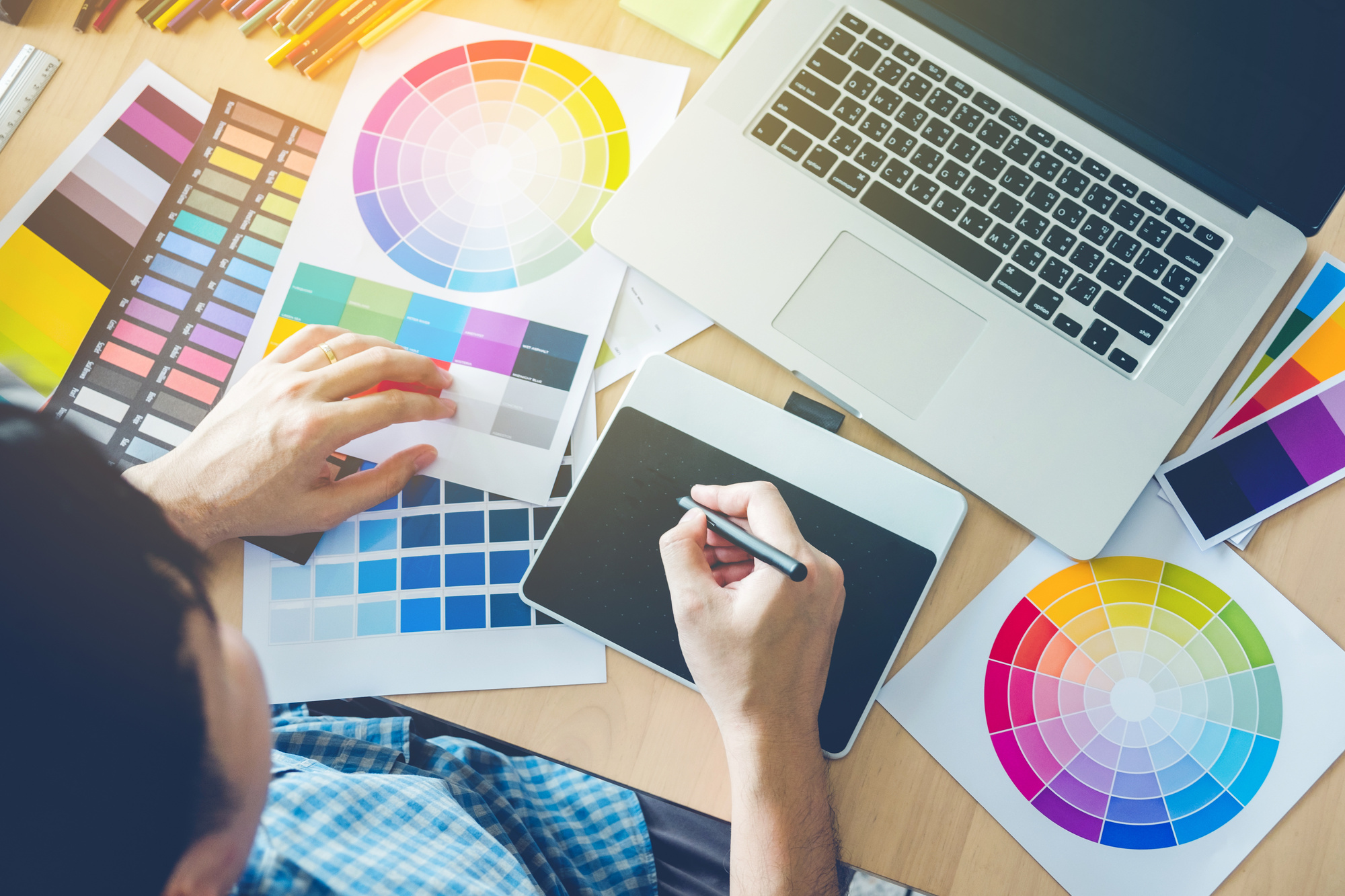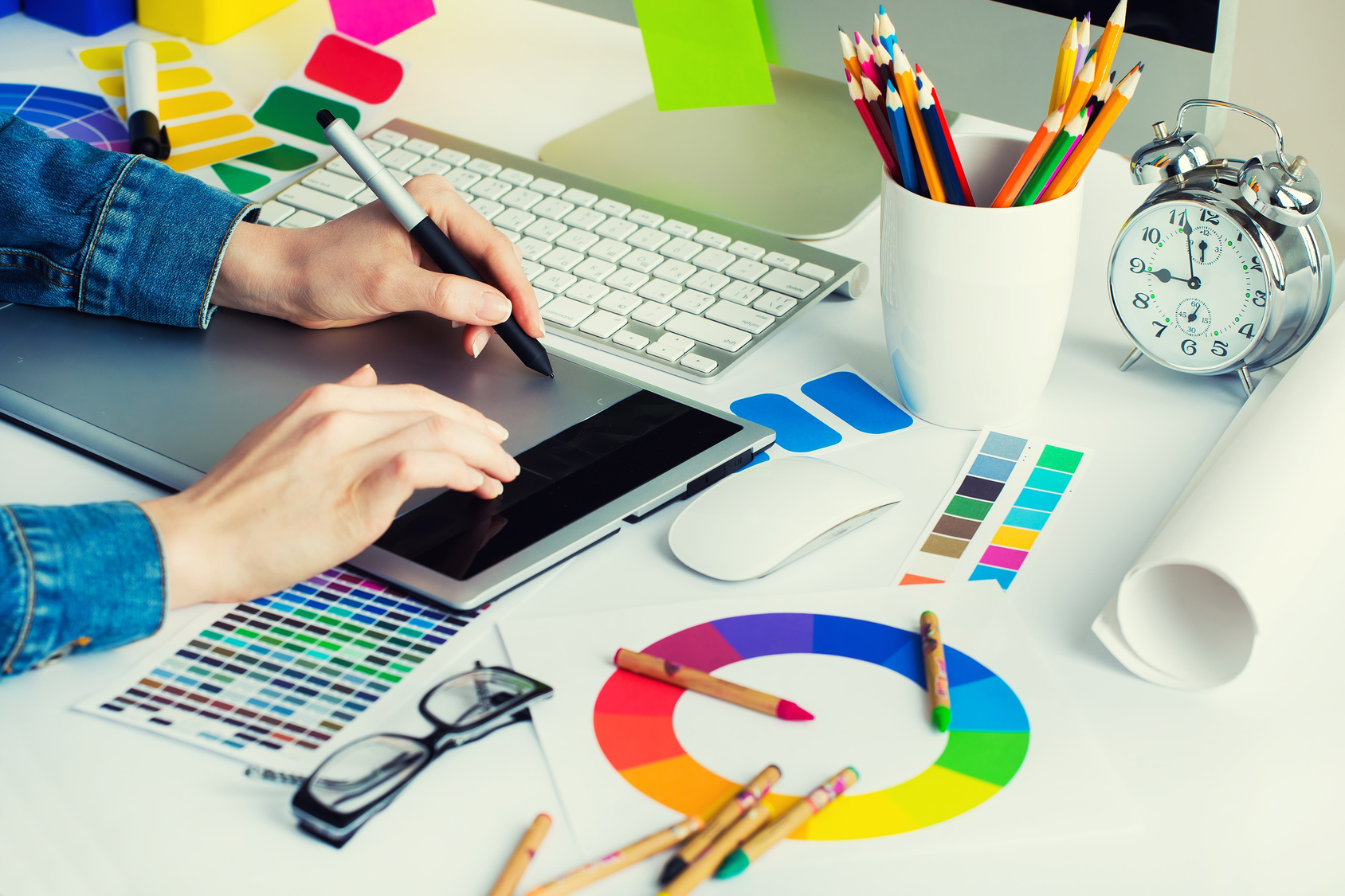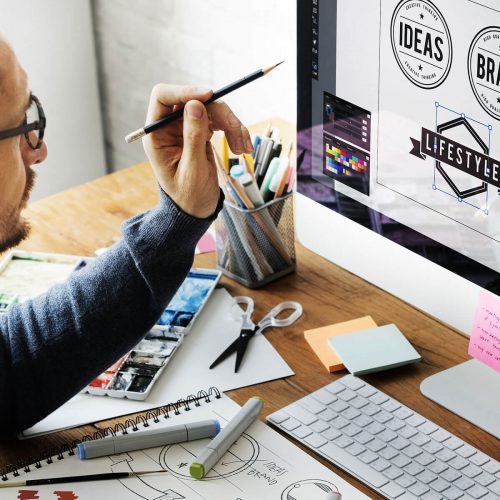Transform Your Business with Stunning Visual Designs Created by Professionals






















Your Creative Vision into Beautiful Image Designs That Your Customers Will Love!
Everyone loves good designs – both customers and business owners alike. That’s why at
Business Inc Online, our trained personnel pay close attention to creating designs that make businesses stand out and leave a lasting impression in the minds of their audiences.
Our team consists of highly experienced graphic designers and marketing strategists that work together to provide custom designs tailored to the needs of each business.
Create Standout Designs that Capture Any Audience’s Attention with Ease
80% of marketers use visual assets in their social media marketing because it’s proven to drive more traffic.
32% of marketers say visual images are the most important form of content for their business.
An estimated 84 percent of communications and online content will be visual by 2022.
But How Do You Go About It?
We offer a convenient and cost-effective solution to give you the best design outcomes. Our team of experienced professionals is equipped with the latest tools and techniques to ensure the highest quality results while meeting your individual needs and budget. Our services range from logo design, website design, animation, business package creation and much more.




Another Option will be to Hire a Professional
Our team of experienced professionals strives to provide you with reliable, high-quality services that exceed your expectations. We provide websites and logo designs, professional illustrations, and marketing materials to clients at an affordable price. We leverage our team of experienced graphic designers to ensure timely delivery and reliable work on every project.
But What If There’s a Better Way For You
Our team of dedicated professionals works closely with clients to create stunning visuals that will capture the attention of their desired target audience.
Now, That’s Where We Come In
At Business Inc Online, we make sure each of our clients receive quality graphics that can help increase their sales, reputation and success rate. Our team is composed of highly experienced professionals from different industries and backgrounds, who work together to provide excellent results in a timely manner.
We provide custom designs that are tailored specifically to your business needs or personal taste.
Book A Call With Us Today!


Create Attractive Graphic Designs Quickly and Easily, and Attract the Right Customers!
Our vast experience in customer service and creativity will help ensure that your business is set up for success. Contact us now to get started!
Our Experts are Ready to Help!
Connect with one of our Local Experts today and discuss your requirements. Free advice.


Want to connect with a marketing expert? Dial in!
123 - 456 - 7890


Enhance Your Brand’s Identity With Graphics Design
Creating a strong brand identity is essential for any business in today's competitive market. A well-crafted brand identity can help your business stand out from the competition, attract new customers, and build trust with your existing clients. However, developing a brand identity requires more than just a great logo and catchy tagline. It requires a comprehensive and cohesive design strategy that effectively communicates your brand's values, mission, and personality. This is where graphics design comes into play.
Graphics design is a powerful tool that can help businesses create a visual identity that resonates with their target audience. It involves the use of typography, color, imagery, and layout to convey a brand's message and evoke emotions in the viewer. The right graphics design strategy can make a significant impact on your brand awareness and identity. It can help you stand out from the competition, build brand recognition, and create a consistent look and feel across all marketing materials.
What is Graphics Design?
Graphic design is the art of creating visual content to convey a message or communicate an idea. It involves combining typography, images, colors, and layout to create visual communication that engages, informs, and inspires audiences. A graphic designer's primary goal is to create designs that are visually appealing, effective, and memorable. They use a variety of software tools such as Adobe Photoshop, Illustrator, and InDesign to create designs for print media, digital media, and other communication platforms. A good graphic designer needs to have excellent communication skills, creativity, and an eye for detail to create designs that effectively convey the message and achieve the desired goals.
Table of Contents
- Brand’s Identity With Graphics Design
- What is Graphics Design?
- Four Types of Graphics Designers
- Elements of Graphics Design
- 3 methods of Graphics Design
- 7 Types of Graphics Design
- Main Types of Graphics Design
- Is Graphics Design Hard?
- Graphics Design Skills
- What Skills are Required For Graphics Design?
- How Do I Obtain These Skills?
- Get Started With Us Today!
What Our Client Says






What are the Four Types of Graphics Designers?
1.
Graphic Designer
A graphic designer is a professional who uses visual elements to communicate ideas, messages, and concepts. They combine art and technology to create designs that meet the needs of their clients. They work with a variety of mediums, such as print, digital, and multimedia, to create logos, brochures, websites, advertisements, and more. A graphic designer needs to have a strong understanding of design principles, color theory, typography, and software tools. They also need to be able to work collaboratively with clients and other team members to ensure that their designs meet the desired objectives. A successful graphic designer is creative, detail-oriented, and has a strong portfolio that showcases their skills and expertise.
2.
Illustrator
Illustrator is a versatile software application developed by Adobe Systems. It is used extensively by graphic designers, illustrators, and artists to create vector graphics. Illustrator enables users to create stunning designs using various tools and features such as the pen tool, shape tools, and brushes. The software is known for its outstanding ability to create precise and scalable vector graphics. It is also compatible with other Adobe products such as Photoshop and InDesign, making it a valuable tool for users who work across different platforms. Illustrator is a must-have tool for anyone who wants to create stunning graphics and designs efficiently and effectively.
3.
Web Designer
A web designer is a professional who is responsible for designing and developing websites. They have a strong understanding of the principles of design, user experience, and web development. A web designer's primary goal is to create a website that is visually appealing, easy to navigate, and functional for its intended audience. They work with clients to understand their specific needs and design a website that meets those requirements. Web designers use a range of tools, including graphic design software and coding languages, to create unique designs that are optimized for the web. They are also responsible for ensuring that the website is responsive and accessible across different devices and platforms. A web designer plays a crucial role in creating a successful online presence for businesses and organizations.
4.
Multimedia Designers
Multimedia designers are creative professionals who specialize in developing engaging visual content that blends various types of media to deliver a compelling message. They use software tools and techniques to create animations, videos, graphics, and other multimedia elements for use in various industries, including advertising, marketing, education, and entertainment. These designers must have excellent artistic skills, an eye for detail, and a deep understanding of the latest design trends and technologies. They work closely with clients to understand their needs, develop concepts, and create multimedia content that meets their expectations. A successful multimedia designer must be passionate, innovative, and adaptable to stay ahead of the curve in a constantly evolving industry.
Table of Contents
- Brand’s Identity With Graphics Design
- What is Graphics Design?
- Four Types of Graphics Designers
- Elements of Graphics Design
- 3 methods of Graphics Design
- 7 Types of Graphics Design
- Main Types of Graphics Design
- Is Graphics Design Hard?
- Graphics Design Skills
- What Skills are Required For Graphics Design?
- How Do I Obtain These Skills?
- Get Started With Us Today!
Ready to Grow? Get your FREE Quote Today!
Elements of Graphics Design
In today's digital age, it's essential to have a solid understanding of graphic design principles to make an impact in the corporate world. From print to digital media, graphic design is a fundamental part of our daily lives, and understanding its core elements can enhance its effectiveness. It can help communicate a message, create a brand identity, and leave a lasting impression on the audience. In this blog post, we'll dive into the essential elements of graphic design that every professional should be aware of.
Firstly, we'll explore the importance of color theory in graphic design. Colors evoke emotions, and a well-thought-out color palette can create a powerful impact on your audience. We'll also take a look at typography, which is not just the choice of font but also the arrangement of letters and words. It's essential to choose the right font and size to create a harmonious flow of text.
1.
Images
When it comes to effective communication, images are a powerful tool. They can convey complex ideas and emotions quickly and effectively, making them an essential part of any visual communication strategy. Whether you're creating marketing materials, designing websites, or crafting presentations, images can help you capture your audience's attention and communicate your message in a way that resonates with them. Moreover, with the proliferation of digital media, images have become even more important, as they can be easily shared and disseminated through various channels. Therefore, it's essential to understand the different types of images, their properties, and how to use them effectively to create compelling visual content that engages and inspires your audience.
2.
Color
Color is an essential element in design, and it plays a crucial role in conveying emotions and messages. Understanding color psychology is crucial for designers to create the desired effect in their design. The color wheel consists of primary, secondary, and tertiary colors, and it is used to create harmonious color schemes. Warm colors like red, orange, and yellow evoke feelings of excitement and passion, while cool colors like blue, green, and purple have a calming effect. Additionally, colors can have cultural and social significance, and it's essential to be sensitive to these when creating designs for different audiences. A thoughtful and intentional use of color can make a design stand out and communicate effectively.
3.
The Use of Typography
The use of typography is an essential element in any form of communication, whether in print or digital media. It is not just about choosing a font style or size, but also about understanding the purpose and context of the message being conveyed. Typography helps to establish hierarchy, provide visual interest, and create a readable and cohesive design. The typeface selected can convey a message on its own, as each font has unique characteristics that can influence how the message is perceived. Typography should be used strategically to guide the reader's eye, highlight important information and evoke a particular emotion or mood. When executed effectively, typography can enhance the overall impact and effectiveness of the message being communicated.
4.
Line
A line can be defined as a continuous mark created by a point moving in space. In the context of art and design, lines are a fundamental element used to create shape, form, texture, and movement. They can be thick or thin, straight or curved, horizontal or vertical, and can vary in tone, color, and texture. The use of lines can evoke different emotions and convey varying messages in communication. They play a crucial role in creating visual hierarchy and guiding the viewer's eye through a composition. Understanding the power of lines in design and art is essential in creating effective and impactful visual communication.
5.
Shape
Shape is an important element of design that can greatly impact the visual appeal and functionality of any project. Whether it be in graphic design, architecture, or product design, the shape of an object or image can communicate a specific message or evoke a particular emotion. Shapes can be simple or complex, organic or geometric, and can be used to create balance, movement, or contrast within a design. It is important to consider the shape of an object in relation to its intended use and audience, as well as its surrounding environment. A well-chosen shape can enhance the overall aesthetic and effectiveness of a design.
6.
Balance
Balance is a critical aspect of any professional and personal life. It refers to the state of equilibrium where different aspects of one's life are in harmony, allowing an individual to function optimally. Achieving balance is essential to maintain good health, reduce stress, and promote productivity. In the professional arena, balance can help individuals manage their workload effectively, avoid burnout, and maintain a healthy work-life balance. It is important to prioritize tasks, delegate responsibilities, and take breaks to avoid overworking. In personal life, balance means taking care of physical, emotional, and spiritual needs. It involves nurturing relationships, pursuing hobbies, and taking time to rest and recharge. Striving for balance is crucial for long-term success and overall well-being.
7.
Contrast
Contrast is an essential element of design, photography, and art. The concept refers to the differences between two or more elements in a composition, such as color, shape, texture, or size. Contrast is used to create visual interest and to guide the viewer's attention towards important parts of the image. High contrast can create drama and intensity, while low contrast can convey a sense of calmness and harmony. A skilled designer or photographer knows how to balance contrast effectively to achieve the desired outcome. Whether in print, digital media, or physical space, contrast plays a vital role in communicating and evoking emotions.
8.
Unity
Unity is a powerful force that brings people together, regardless of their differences. It is the act of working towards a common goal and supporting one another in achieving it. In a professional setting, unity can lead to increased productivity, better collaboration, and a sense of shared purpose among team members. By fostering an environment of unity, individuals can put aside their personal biases and work towards achieving a common objective. This can be achieved through effective communication, mutual respect, and a willingness to listen to different perspectives. In today's complex and ever-changing business environment, unity is more important than ever in achieving success and driving positive change.
9.
Illustration
Illustration is the art of visually communicating a message or idea through images. As a medium, it is versatile, able to evoke emotions, convey complex concepts and provide visual commentary. Illustrations can be found in a wide range of formats, from children's books and advertisements to technical manuals and scientific journals. Skilled illustrators use a variety of techniques to create their work, including traditional media such as pen and ink, watercolors, and pencils, as well as digital tools like graphic tablets and software. Successful illustration requires creativity, technical skill, and an ability to effectively communicate with clients or collaborators.
What are the 3 methods of Graphics Design?
Graphic design is the art and skill of creating visual content to communicate messages and ideas effectively. It is a crucial aspect of marketing and branding in today's digital world. The primary goal of graphic design is to enhance the user experience by using visual elements to convey information. There are various methods of graphic design, but in this post, we will be discussing the three most common ones. The three methods are: traditional graphic design, digital graphic design, and user interface (UI) design.
Traditional graphic design involves using physical materials such as paper, paint, and pencils. It requires a hands-on approach to creating designs, which makes it appealing to those who enjoy traditional art forms. Digital graphic design, on the other hand, involves using computer software to create designs. This method is highly efficient and allows designers to create complex designs quickly. Finally, UI design is a more specific type of digital graphic design that focuses on creating interfaces for applications and websites. It requires an understanding of user experience and user
Table of Contents
- Brand’s Identity With Graphics Design
- What is Graphics Design?
- Four Types of Graphics Designers
- Elements of Graphics Design
- 3 methods of Graphics Design
- 7 Types of Graphics Design
- Main Types of Graphics Design
- Is Graphics Design Hard?
- Graphics Design Skills
- What Skills are Required For Graphics Design?
- How Do I Obtain These Skills?
- Get Started With Us Today!


We have financed over
3 BILLION+
for our clients
Discover how we can help your business.
What are the 7 Types of Graphics Design?
1.
Pictorials
Pictorials are a powerful visual tool that can convey complex information in a clear and concise manner. These graphical representations can be used to illustrate data, processes, concepts, and relationships in various fields such as science, engineering, business, and education. A well-designed pictorial can enhance understanding, engage the audience, and communicate ideas more effectively than text alone.
2.
Illustrations
Illustrations are a powerful tool in visual communication that can convey complex ideas and emotions through simple images. They can be used in a variety of mediums including books, magazines, advertisements, and websites.
3.
Logos
Logos, a Greek word meaning “logic” or “reasoning”, refers to the use of logic and rationality in argumentation. In branding and marketing, a logo is a graphical representation of a company, product, or service.
4.
Icons
Icons are graphical representations used to communicate information, concepts, and actions in a user interface. They serve as a visual shorthand that simplifies complex ideas and creates a more intuitive user experience. Icon design requires careful consideration of the target audience, the platform, and the purpose of the icon.
5.
Symbols
Symbols are an essential component of communication and human expression. They are visual representations that convey meaning beyond their physical form. Symbols can be used to convey complex ideas, emotions, and concepts that would be difficult to express through words alone. They can also be used to create a sense of unity and identity among individuals or groups.
6.
Digital Art
Digital art is a rapidly evolving medium that has gained immense popularity in recent years. It is a form of art that uses digital technology to create images, animations, and other forms of visual content. The use of digital tools has enabled artists to create intricate and complex designs, as well as experiment with new techniques and styles.
7.
Typography
Typography is the art and technique of arranging type to make written language legible, readable, and appealing when displayed. It is a crucial element in graphic design, advertising, and marketing materials.
Table of Contents
- Brand’s Identity With Graphics Design
- What is Graphics Design?
- Four Types of Graphics Designers
- Elements of Graphics Design
- 3 methods of Graphics Design
- 7 Types of Graphics Design
- Main Types of Graphics Design
- Is Graphics Design Hard?
- Graphics Design Skills
- What Skills are Required For Graphics Design?
- How Do I Obtain These Skills?
- Get Started With Us Today!
Ready to speak with our experts?
Looking for Funding?
$3,000,000,000+
IN FUNDING SECURED FOR CLIENTS
Get Clients through our
155,000,000+
CLIENT ACQUISITION DATABASE
Accelerate your ROI by
200-1000%
FROM OUR DIGITAL CHAT BOT SERVICE
Increase Brand Awareness with
2,200,000+
SOCIAL MEDIA & JOURNALIST ACCOUNTS
What are the Main Types of Graphics Design?
Branding Design
Branding design is a vital component of any successful business strategy. It involves creating a distinct visual identity for a brand that resonates with its target audience and sets it apart from its competitors. Effective branding design is more than just a logo or a catchy tagline. It is about understanding the core values and mission of a company and translating that into a cohesive brand story.
Publishing Design
Publishing design is a critical component of the publishing industry that requires a high level of expertise and creativity. It involves the layout, formatting, and overall visual appeal of books, magazines, newspapers, and other printed materials. Effective publishing design can make a significant difference in the success of a publication by attracting readers and conveying information in an engaging and accessible manner.
Website Design
Website design is a crucial aspect of any online business, as it plays a significant role in attracting and retaining customers. A well-designed website can enhance the user experience and improve customer engagement, resulting in increased conversions and revenue. It is essential to consider various factors when designing a website, such as usability, accessibility, and aesthetics. The website should be easy to navigate, have clear and concise messaging, and be visually appealing.
Animation Design
Animation design is a complex process that involves careful planning, creativity, and technical expertise. It is the art of bringing characters and stories to life through the use of moving images, and it requires a deep understanding of the principles of animation, including timing, spacing, and weight. Animation design also involves a keen eye for detail, as the smallest changes in facial expressions or body movement can make a big impact on the overall effectiveness of the animation
Product Design
Product design is a critical aspect of any business, and it involves creating innovative and functional products that meet the needs of customers. Successful product design requires a deep understanding of the market, user experience, and technical constraints.
Print Design
Print design is an essential component of any marketing or branding strategy. The design elements that are used in print materials such as brochures, flyers, and business cards can leave a lasting impression on potential customers.
Table of Contents
- Brand’s Identity With Graphics Design
- What is Graphics Design?
- Four Types of Graphics Designers
- Elements of Graphics Design
- 3 methods of Graphics Design
- 7 Types of Graphics Design
- Main Types of Graphics Design
- Is Graphics Design Hard?
- Graphics Design Skills
- What Skills are Required For Graphics Design?
- How Do I Obtain These Skills?
- Get Started With Us Today!
Is Graphics Design Hard?
Graphic design is an art form that combines creativity, technology, and a deep understanding of visual communication. It involves designing and creating visual content that communicates a message, idea or information to an audience. With its increasing popularity, the question of whether graphic design is hard or not has become a topic of debate. Some believe that it is a challenging field that requires specialized skills and technical knowledge, while others argue that it is more accessible than ever before due to advanced tools and software.
In this blog post, we will delve into the question of whether graphic design is hard or not. We will explore the different skills and abilities required to succeed in this field, the challenges that graphic designers face, and the rewarding aspects of the profession. We will also outline some of the misconceptions about graphic design and offer tips on how to become a successful graphic designer.
What are Graphics Design Skills?
In today's digital age, graphics design has become an essential element in the success of any business. A well-designed website or marketing material can mean the difference between attracting new customers and losing them to the competition. However, not everyone has the skills or knowledge required to create effective designs. That's where graphics design skills come into play.
Graphics design skills refer to the abilities and expertise required to bring ideas and concepts to life through visual communication. These skills encompass a wide range of areas such as typography, color theory, layout, composition, and software proficiency. A graphics designer needs to possess a deep understanding of design principles and trends, as well as the technical skills to utilize design software and tools effectively.
Table of Contents
- Brand’s Identity With Graphics Design
- What is Graphics Design?
- Four Types of Graphics Designers
- Elements of Graphics Design
- 3 methods of Graphics Design
- 7 Types of Graphics Design
- Main Types of Graphics Design
- Is Graphics Design Hard?
- Graphics Design Skills
- What Skills are Required For Graphics Design?
- How Do I Obtain These Skills?
- Get Started With Us Today!
Ready to speak with our experts?
What Skills are Required For Graphics Design?
Good Communication Skills
Good communication skills are essential for success in any professional environment. The ability to communicate effectively with colleagues, clients, and customers is critical for building strong relationships and achieving business objectives. Effective communication involves not only clarity of expression but also active listening, empathy, and a willingness to adapt to different personalities and communication styles. Good communication skills can facilitate conflict resolution, foster teamwork, and enhance productivity. To develop strong communication skills, individuals should practice clear and concise verbal and written communication, actively listen to others, and seek feedback to improve their communication style. Overall, good communication skills are a cornerstone of professional success and should be prioritized in any career development plan.
A Strong Understanding of Strategy and the Details That Make a Great Graphic Design
To deliver an effective graphic design, it is crucial to have a strong understanding of the strategy behind it. A great graphic design is more than just an aesthetically pleasing arrangement of images and text. It is a strategic communication tool that conveys a message to the target audience. Therefore, a designer must have a clear understanding of the target audience, the message they want to convey, and the desired action they want the audience to take. In addition, attention to detail is essential to create a great graphic design. The small details like color, typography, and imagery can make a significant impact on the overall design. A thorough understanding of strategy and attention to detail are the key ingredients for creating an effective and impactful graphic design
The Ability to Work Independently and on a Team
Having the ability to work independently and on a team are both critical skills in any professional environment. The capacity to work independently demonstrates an individual's self-sufficiency, time-management, and problem-solving abilities. It also shows that they can take accountability for their work and deliver quality results. On the other hand, working collaboratively with others showcases an individual's communication, leadership, and teamwork skills. It is crucial to be able to work in a team to achieve shared goals, to be flexible and adaptable to different work styles and to be open to constructive feedback. Being able to balance both skills can enhance an individual's performance and effectiveness in any work setting.
An Eye For Detail
Having an eye for detail is a crucial skill in any professional setting. It is the ability to observe and analyze information with precision, accuracy, and thoroughness, while seeking perfection in every task. This quality is highly valued in fields such as design, engineering, and architecture, where even the slightest mistake can have catastrophic consequences. Attention to detail ensures that every aspect of a project is executed flawlessly, resulting in a higher quality output. Moreover, it demonstrates a level of commitment, professionalism, and pride in one's work. In conclusion, having an eye for detail is an essential attribute that sets professionals apart and distinguishes them from their peers.
Artistic Skill
Artistic skill is an essential element of any successful career in the arts. It's a combination of creativity, technical expertise, and the ability to communicate emotions and ideas through visual media. The development of artistic skills requires dedication, practice, and a willingness to take risks and experiment with different techniques and mediums. It's not just about being able to draw or paint realistically, but also about developing a unique style and voice that sets you apart from others. An artist with high levels of artistic skill can create compelling and evocative works that engage and inspire viewers, and can open up new opportunities for professional success in the art world.
Computer Proficiency
In today's digital age, computer proficiency has become an essential skill for individuals in almost every industry. Possessing a strong command over various computer programs and tools is crucial for maximizing productivity, efficiency, and accuracy in the workplace. It includes advanced knowledge of software applications, operating systems, hardware configurations, and troubleshooting techniques. Moreover, computer proficiency is not limited to technical skills only; it also entails effective communication, collaboration, and critical thinking abilities. In short, computer proficiency is a critical skill that can help professionals stay competitive, agile, and relevant in the ever-changing business landscape. Therefore, it is imperative to invest time and effort into improving one's computer proficiency to achieve professional success.
Presentation Skills
Effective presentation skills are essential for individuals in today's fast-paced business world. Whether giving a presentation to colleagues, clients, or stakeholders, the ability to communicate ideas clearly and persuasively can make or break a project or proposal. Presenters must be able to engage their audience, convey information succinctly, and leave a lasting impression. This requires a combination of preparation, delivery, and strong communication skills. Effective presenters use visual aids, such as slides or diagrams, to support their message and engage their audience. They also use body language, tone of voice, and eye contact to convey confidence and build rapport with their audience. By honing their presentation skills, professionals can enhance their credibility and advance their careers.
Self-Motivation
Self-motivation is an essential trait for achieving success in both personal and professional life. It is the ability to push oneself to achieve goals and overcome any obstacles in the way. Self-motivated individuals are driven by their passion and a strong desire to achieve their goals. They are able to stay focused, take initiative, and persevere through tough times. Self-motivation is crucial in today's highly competitive and fast-paced world, where success often depends on one's ability to stay motivated and continuously improve. It is a skill that can be developed through practice, discipline, and a positive mindset. In order to succeed in life, it is important to cultivate and maintain a sense of self-motivation.
Creative Thinking
Our services include one-on-one consultations focused on discovering and nurturing creativity, as well as weekly coaching sessions that can be tailored to any individual's needs. With Creativity Solutions, you'll find yourself back in your creative groove in no time!
Perseverance
Perseverance is an essential trait that every successful individual exhibits. It is the ability to keep striving towards a goal, despite obstacles and setbacks. Perseverance requires determination, resilience, and a positive attitude. Individuals who possess perseverance are not easily deterred by challenges, rather they view them as opportunities to learn and grow. They remain focused on their end goal and are willing to put in the hard work and effort required to achieve it. Perseverance is a quality that can be developed and strengthened through practice and discipline. It is a fundamental aspect of personal and professional success, and those who embody it are more likely to achieve their aspirations and dreams.
Table of Contents
- Brand’s Identity With Graphics Design
- What is Graphics Design?
- Four Types of Graphics Designers
- Elements of Graphics Design
- 3 methods of Graphics Design
- 7 Types of Graphics Design
- Main Types of Graphics Design
- Is Graphics Design Hard?
- Graphics Design Skills
- What Skills are Required For Graphics Design?
- How Do I Obtain These Skills?
- Get Started With Us Today!
SUBSCRIBE & get a chance to
win Upto $250K Funding
Join our customer database and you will be entered in our quarterly bonus giveaways!
How Do I Obtain These Skills?
As individuals, we must constantly strive to improve ourselves and our skills in order to succeed in our personal and professional lives. Whether you're a recent graduate just entering the workforce or a seasoned professional looking to advance in your career, the question of “how do I obtain these skills?” is likely at the forefront of your mind. In today's ever-evolving job market, possessing a diverse set of skills is essential to remaining competitive and marketable. However, with such a vast array of skills and knowledge available, it can be difficult to know where to start or which skills are most valuable. This blog post will provide practical advice and actionable steps to help you identify and acquire the skills necessary to achieve your personal and professional goals. From online courses and certifications to mentorship and networking, we will explore a variety of avenues for skill acquisition that can help you take your career to the next level. By the end of this post, you will have a clearer understanding of how to identify the skills you need
Get Started With Us Today!
In conclusion, graphics design is a vital and constantly evolving field that plays a significant role in shaping the visual representation of various brands and businesses. Whether designing a logo, creating marketing materials, or developing a website, the skills and knowledge of a graphic designer can make a significant impact on the overall success of a company. As technology continues to advance, the role of graphic designers will only become more critical, and staying up-to-date with the latest trends and tools will be essential for success in this field.
Table of Contents
- Brand’s Identity With Graphics Design
- What is Graphics Design?
- Four Types of Graphics Designers
- Elements of Graphics Design
- 3 methods of Graphics Design
- 7 Types of Graphics Design
- Main Types of Graphics Design
- Is Graphics Design Hard?
- Graphics Design Skills
- What Skills are Required For Graphics Design?
- How Do I Obtain These Skills?
- Get Started With Us Today!


